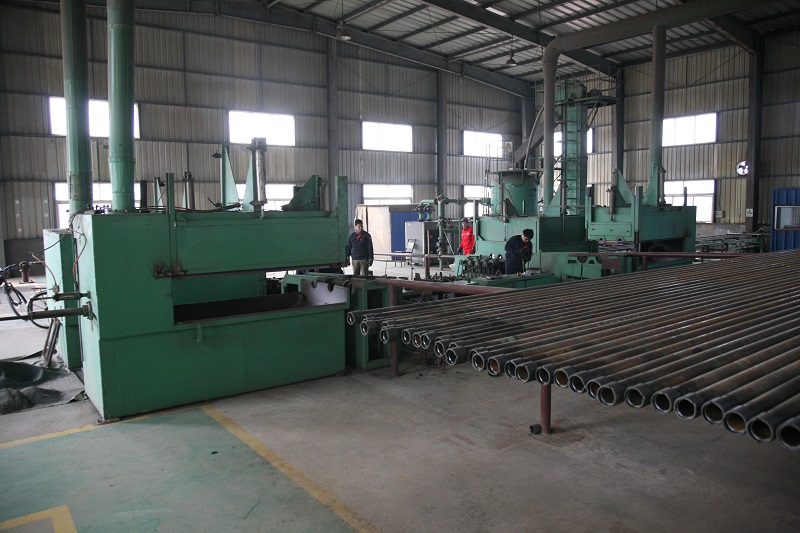Influencing factors of tungsten plating process
Mining and transportation process inside and outside the pipeline working environment is complex and variable, the corrosion of oil wells is caused by dissolved salts (the most important of which is chloride), hydrogen sulfide, carbon dioxide, dissolved oxygen and organic acids, sulfate-reducing bacteria (SRB) and other corrosive media, and the flow rate, temperature and other parameters of the oil well corrosion has a greater impact.
Different factors may cause pitting corrosion, localized corrosion, and corrosion in the whole area of the oil well tubing column. Well inclination, casing deformation, tubing bends, the medium of the producing fluid, and the intrinsic factors of the well have a great influence on the deviatoric abrasion.

The tubing is often subjected to microbial erosion, sand erosion and corrosive effects of acidic gas impurities, which lead to pitting corrosion, perforation, and even breakage and leakage of the gathering pipeline and other safety accidents.
Therefore, it is necessary to take corresponding anti-corrosion measures for the inner wall of the gathering pipeline to improve the corrosion resistance and wear resistance of the inner wall of the pipeline, so as to prolong its service life and enhance the safety.Ni-W-P alloy plating anti-corrosion and wear-resistant performance compared with the traditional anti-corrosion technology has obvious advantages, and at the same time, it has good mechanical properties and stability, which is very suitable for the inner wall of the gathering pipeline to prevent corrosion.
Characteristics of tungsten-based alloys
Metal tungsten is usually steel gray or silver white, characterized by high hardness and mainly hexavalent cations. Due to W6+ has a small ionic radius, high valence and strong polarization ability, thus it is easy to form complex anions, which mainly exists in the form of [WO4]2-, which does not have the ability to electrodeposit alone in aqueous solution, and needs to be deposited in combination with other Fe-group metal cations under the It needs to be deposited in combination with other iron group metal cations. Since tungsten metal is non-toxic, good abrasion resistance, stable in nature and not easy to react with air and strong acids.
Factors affecting the properties of tungsten plating on pumping rod pipe
(1) Concentration of main salt. The amount of tungsten content of tungsten plating layer depends on the concentration of tungsten salt in the plating solution. Tests have proved that the higher the concentration of tungsten salt in the plating solution, the higher the content of tungsten in the tungsten plated layer, which directly affects the hardness of the tungsten plated layer. When the content of tungsten exceeds 44%, the crystal structure changes from crystalline to amorphous.
(2) Influence of complexing agent concentration. It is proved that if the concentration of complexing agent is changed while the concentration of main salt is kept unchanged, the higher the concentration of complexing agent, the lower the tungsten content of tungsten plating layer; the lower the concentration of complexing agent, the higher the tungsten content of tungsten plating layer. Therefore, the concentration of complexing agent should be reduced in the plating solution.
(3) Influence of complexing agent composition on plating layer. In the plating process, the preferred complexing agent is citric acid or citrate, because citric acid is inexpensive and gives a high tungsten content. However, there is a disadvantage in that the addition of citric acid to the plating solution reduces the efficiency of the current, resulting in a thin layer in the same amount of time.
(4) Effect of PH value on the plated layer. When the plating solution is alkaline, tungstate is not easy to be complexed; when the plating solution is acidic, the reaction of hydrogen precipitation is intense, which is easy to cause hydrogen embrittlement of the plating layer, etc. The PH value has a considerable influence on the plating layer, so it is necessary to strictly control the PH value in the plating solution. Tests have proved that if the PH value is controlled in the range of 6.5-7.5, amorphous plating layer can be obtained.
(5) The effect of current density on the plating layer. Increasing the current density will increase the content of tungsten in the tungsten plating layer, but at the same time, it will also increase the amount of hydrogen in the hydrogen precipitation reaction, and the large amount of hydrogen will not only easily cause hydrogen embrittlement of the plating layer and other phenomena, but also reduce the current density. While increasing the current density, stirring can be used. Tests have shown that effective stirring can increase the current density.
(6) Influence of plating bath temperature on plating layer. Ammonia plays the role of complexing agent in the plating process, but as the temperature of the bath increases, ammonia will volatilize a lot.

The increase of bath temperature affects the current efficiency, i.e. the higher the temperature, the higher the current efficiency, and the increase of current efficiency will increase the content of tungsten in the plated layer. When the temperature is higher than 80℃, the ammonia will be decomposed easily; when the temperature is lower than 50℃, the plated layer will lose the metal color. Therefore, the bath temperature is controlled at about 60-70℃.

 By Sun
By Sun

